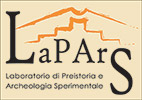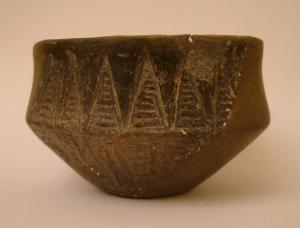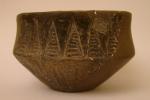Clay and pottery
The processing and uses of clay are fundamental to LaPArS research, not least because of the enormous quantity of primary evidence available from the particularly rich deposits at the site of Canelles.
CLAY
The discovery of mudbricks, plaster and wattle, as well as clear evidence of the use of untreated clay to isolate and protect the surfaces of subterranean structures in the settlement at Canelles, has revealed important information on a raw material which has been widely used in traditional building on the Campidano plain up until the middle of the last century (Melis 2010a).
The leading face of clay blocks had, for the most part, a rectangular form, and less commonly an elliptical, lozenge or wider rectangle outline. In some cases the poor conservation of the fragments makes it impossible to identify the original shape. The most common form is rectangular, followed by blocks with convex surfaces, but there are also examples of concave-convex surfaces and rectangles with one concave surface. The transversal section is usually rectangular, and more rarely convex, trapezoidal or elliptical. The differing shapes and sizes demonstrate that there were different types of bricks, mostly parallelepipeds of medium dimensions, with occasional much larger examples. The recovery of the bricks from secondary deposits makes it difficult to reconstruct the precise role they played in ancient architecture, although some clues can be gained from representations of buildings to be found on the walls of domus de janas tombs. The archaeometric analyses currently underway may give interesting information on the sources of the raw materials, methods of mixing and drying, as well as on building techniques of walls and roofs. If bricks supply information on the elevation of buildings, the elements in torchis, or wattle and daub, would have been used in the construction of external and partition walls, and roofs. The plant materials were presumably reeds and other plants typical of humid areas, considering the proximity to the lagoon at Molentargius. The varying diameters of the hollows left by the canes are evidence of the use of different plant species and differing functions of the various structural elements.
Lastly, around thirty wall-plaster fragments, in rare cases painted, were recovered from different structures. Almost all of them have a clay underlayer with a smoother light coloured surface. The fragments were divided into two ranges of thickness, one between 0.4-0.8 cm and the other 2-4 cm, while the patina was pale yellow in colour. The archaeometric analyses (Mameli, Melis 2008) gave results comparable to those of the plaster fragments from the site at Monte d'Accoddi.
POTTERY
The morpho-technological analysis of the pottery has proved to be an indispensable instrument for reconstructing the chronology and socio-economic organisation of prehistoric villages, and in particular for studying the processes of transition from the Neolithic to the Eneolithic.
The morpho -typological analysis
The typological study of autochthonous pottery traditions of the Sardinian Eneolithic (Melis 1998 and 2000) achieved the result of unifying the data, even on a terminological level, of ascertaining a real chrono-cultural seriation, as well as to reconstruct the genetic relationships between the various cultures and their rapport with the extra-insular world. The seriation, which was later confirmed through radiocarbon testing, shows a gradual evolution in which it is possible to glimpse the innovations and the continuity in the transition from the Neolithic to the Eneolithic and later during the various phases of the Eneolithic.
The combined morpho-technological approach made it possible to find confirmation of these dynamics by making use of the technological data.
The technological analysis
A technological approach gives a ceramics expert an opportunity to maximise the quantity and variety of information on the artefacts being studied as well as on the economic and cultural background in which they were created. Each find examined is the product of an operational sequence (châine opératoire) to be analysed/reconstructed through a rationalisation which leads us to the conclusion that the operations carried out by the artisan covered five separate stages: the selection and preparation of the clay, the shaping, finishing and decoration of the object, and finally the firing.
The analyses are interdisciplinary; from the moment of excavation and through all the phases of subsequent study, all the data necessary to reconstruct the operative sequences of ceramic artefact production, and any interaction with the production sequences of other categories of finds, are gathered, including the identification and the economy of the raw materials, the identification of flawed attempts and objects discarded at different stages of the production process, any utensils that may have been employed in the various sequences, the identification of the structures used for firing, etc.
A macroscopic analysis was conducted on the entire pottery collection, aimed at identifying, documenting and interpreting macro-traces and micro-structures, both of which are diagnostic attributes of the techniques and methods of shaping and finishing. The opportunity to physically examine a large number of finds, together with the experience of the examiner, are of course of fundamental importance.
The data is interpreted analogically, on the basis of material and iconographical descriptions in archaeological and ethno-archaeological literature, consulted in exactly the same way as a comparison collection of finds would be. It is thereby possible to formulate technological hypotheses, verifiable through an interdisciplinary approach employing radiographic and archaeometric analyses and experimental archaeology.
In the specific case of the contexts examined by LaPArS, the integration of typological data with the technological analysis has proven to be a very effective approach.
Regarding Ozieri and Sub-Ozieri contexts it makes it possible to identify changes in techniques, processes and organisation of production, which, simultaneously, are also highlighted in relation to other artisanal activity and more generally, the economic conditions of the Early Eneolithic. In particular the study of artefacts recovered from Building 134 of the Badas area of the settlement at Su Coddu/Canelles, which C 14 datings ascribe to a transitional phase, shows the co-existence of two different technical approaches. A fair number of ceramic containers with hybrid or exclusively Sub-Ozieri morphological characteristics are evidence of a continuation in the Ozieri traditions invested in the phases of the finishing of the form and surfaces, on colour and decoration, in contrast with the functional opportunism which generally characterised the pottery that has so far been studied from the Badas area. At the same time, these technological "anomalies" are to be nevertheless found in association with morphologically and technologically analogous materials to those originating from later dated buildings, evidence of the gradual nature of changes in the activity of pottery production.
In the same way, the study of the pre- and proto-historic pottery of the necropolis of S'Elighe Entosu, Usini, Sassari, was undertaken with an integrated approach of the morphological and technological analyses, where each field increasingly became a support for the other in the attempt to overcome the problems relating to the fragmentary character of the available finds. In fact, on the one hand the morphological analysis made it possible to direct and focus, in turn, the technological analysis, and to verify the technical characteristics relating to each separate cultural phase; on the other, the technological analysis supported the morphological analysis, helping to identify the cultural reference point in several problematic cases. Notwithstanding the fragmentary nature of the material and the peculiarities related to the funerary character of the context, it has been possible to distinguish numerous pottery forms and single artefacts, identifying and documenting various techniques of shaping, finishing and decoration.


